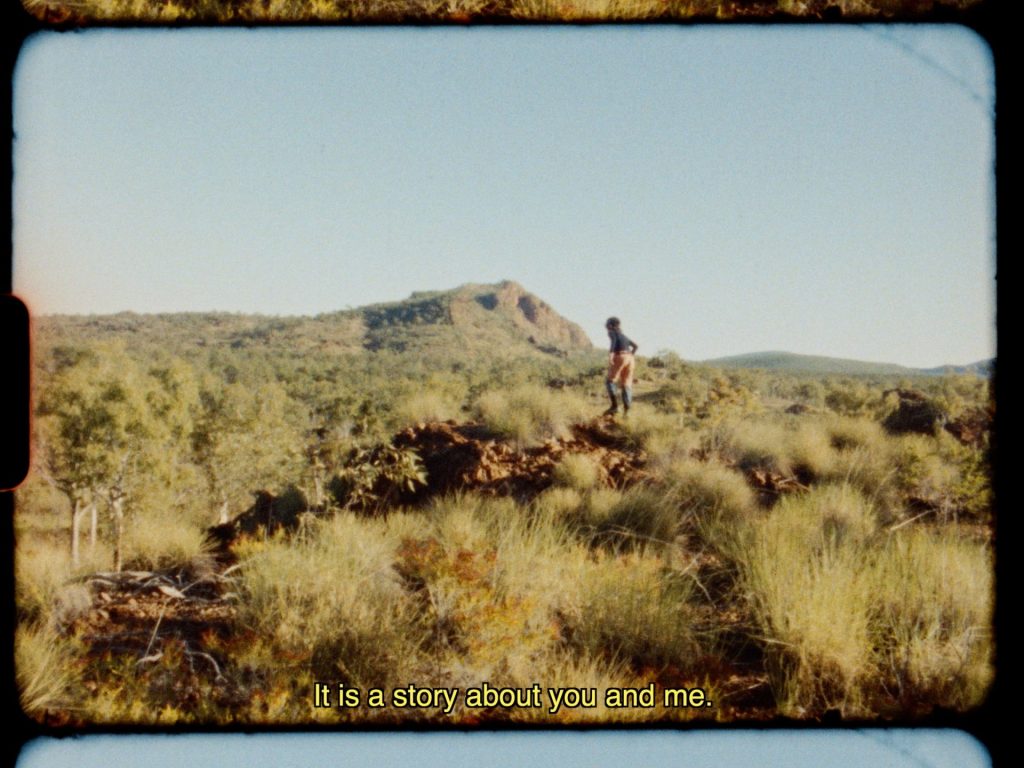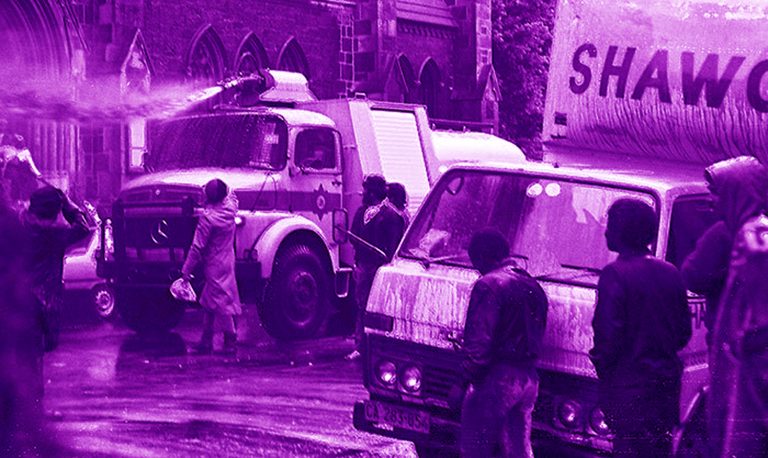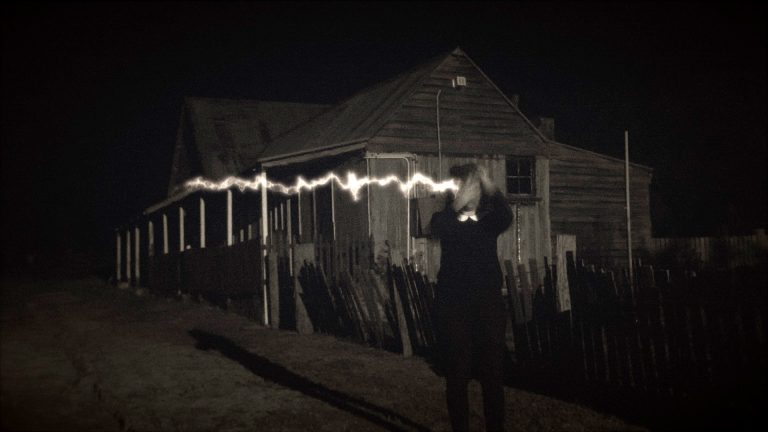Looking Up is an outdoor projection series featuring works by several artists who all have a relationship with Western Australia. Featuring works from 1997 to 2023, the program presents diverse perspectives linked by their exploration of social and cultural ties to place, from sites as diverse as the Pilbara, East Kimberley, the Wheatbelt, Perth, Thailand and Germany.
Looking Up celebrates the generosity and endeavour of these artists as they envision the world and their place within it. Many of these works arise out of painful, complex or disappearing histories that are particular to their place; our place. To suggest that things are ‘looking up’ is to envisage a positive change, a turn for the better. As we look up at the projected works on the wall of the State Library building, we find the possibility of hope in acts of truth-telling and remembering.
Looking Up is accompanied by the work Surveilling a Crime Scene (2021-23) by WA artist Alana Hunt. This work examines the materialisation of non-indigenous life on Miriwoong Country and proposes colonisation not as history but as a continuous and present violence, one that is deceptively ordinary.
Featured Artists
Nathan Beard
Peggy Madij Griffiths
Tanya Lee
Pilar Mata Dupont
Brad Rimmer
Michele Theunissen
Curtis Taylor
Alana Hunt
Film Descriptions
Nathan Beard – A Remembrance
A Remembrance (2019) documents a trip taken by Nathan Beard with his mother to her former home province of Pak Chong, Thailand. Over the course of a day, they visited sites relevant to the life she led there with her first husband Sompong, a relationship tragically cut short by his murder in 1973.
‘The film traces an attempt to contextualise this unknown chapter of my mother’s life in her own words; tacitly acknowledging that were it not for this tragedy, then my mother wouldn’t have eventually met my father and started her new life in Australia.’ – Nathan Beard
Peggy Madij Griffiths – Woolangem Balaj Gida
Woolangem Balaj Gida (At First Sight) (2021) is an animation spoken in Miriwoong with both English and Miriwoong subtitles. Griffith‘s’ works on paper form a backdrop to a narrative that tells the story of the first time Griffith’s’ mother saw a gadiya (white man) on her Country. Griffiths depicts dreaming and hunting sites and draws attention to the troubling histories Griffiths and her family endured.
‘…people come to my Country, and it is beautiful, but they do not know what happened here’ – Peggy Madij Griffiths
Tanya Lee – Curtilage Cleveland Street, Floreat & Mosman Park
Curtilage Cleveland Street, Floreat & Mosman Park (2016) both transgress and maintain physical and intimate boundaries between people. A pole stretched out of a window reaches into the home of a neighbour, linking two residences, as they awkwardly perform intimate acts for each other – painstakingly brushing each other’s hair, and teeth at an absurd distance. Drawing its name from disciplines of urban planning, curtilage is a term that describes the space between a building and its boundary. The performers featured in the series of actions are ‘real’ neighbours, recruited by the artist through door-knocking and other strategies. Reaching across the boundary between their residences, the works bring authentic assumptions and histories to these unfolding actions between neighbours.
Pilar Mata Dupont – Mountain
Mountain (2015) by Pilar Mata Dupont investigates Sigmund Freud’s connection to the neighbouring villages of Berchtesgaden and Schönau am Königssee in Bavaria, Germany; his seminal work ‘The Interpretation of Dreams’ was written in Schönau in 1989, whilst living in a rented house. The mountains in this region that overlook these villages, in particular the Obersalzberg, are infamous as the base for the National Socialists from the 1920’s.
With dialogue drawn from the writing of Freud, the film’s sonorous voice-over refers to the unconscious, and to tyranny and oppression. Linked to the imagery that moves through and under the shadow of the mountain, this work creates a new account for this site- one that is speculative, dreamlike, and always relevant.
Brad Rimmer – Nowhere Near
Brad Rimmer’s Nowhere Near (2023) series reflects on a fleeting, bygone era in the Wheatbelt of Western Australia, and the remnants of the region’s languishing town halls. Once central to a farming community’s social life, they now lie destitute, maybe repurposed, decaying or even demolished. They are a poignant reflection on the past, what we leave behind and what remains. For Looking Up, a selection of 40 still images from the Nowhere Near photographic series is compiled into a four-minute slideshow.
Michele Theunissen – Elastic Boundaries
The fixed camera of Michele Theunissen’s Elastic Boundaries (1997) shows a young girl tumbling in and out of frame. The slow-motion movement of her body through the frame is mesmerising, boundless as she moves as if through time and space.
‘Elastic boundaries was shot on a specialised slow motion 16mm camera, showing my daughter tumbling in the air as she bounces on a trampoline.’ Michele Theunissen.
Exhibited as a multi-channel film installation at Artspace Sydney, Looking Up presents a four-minute single-channel version of this multi-part work.
Curtis Taylor – Battles with Alcoholism
Battle with Alcoholism (2021) is part of a body of work Curtis Taylor made in response to the site of Goolagatup. The artist references the significance of Goolagatup to Aboriginal people, alongside the history of Heathcote Hospital. The hospital was built in 1929 to treat people who experienced mental disorders and was operational on the site of Goolagatup until 1994.
Emotive and personal, this work considers the artist’s own struggles alongside those of others, whether with addiction or other pains, including those who once left country to travel to Heathcote to receive treatment. The artist wraps himself in bandages, indicating pain and struggle, but also references treatment, the possibility of healing, of ‘getting better’.
Alana Hunt – Surveilling A Crime Scene
Alana Hunt’s Surveilling A Crime Scene (2021–23) examines the materialisation of non-indigenous life on Miriwoong Country, seen through the town of Kununurra and its surrounds, and the violence that lies within aspirations for economic growth, leisure, and a home, all on someone else’s land. Filmed on Super 8mm film and framed like a postcard, the soundtrack has a jaunty sensibility that works alongside the film’s persistent recognition of colonisation not as a past historical moment, but as an ongoing and present violence.





